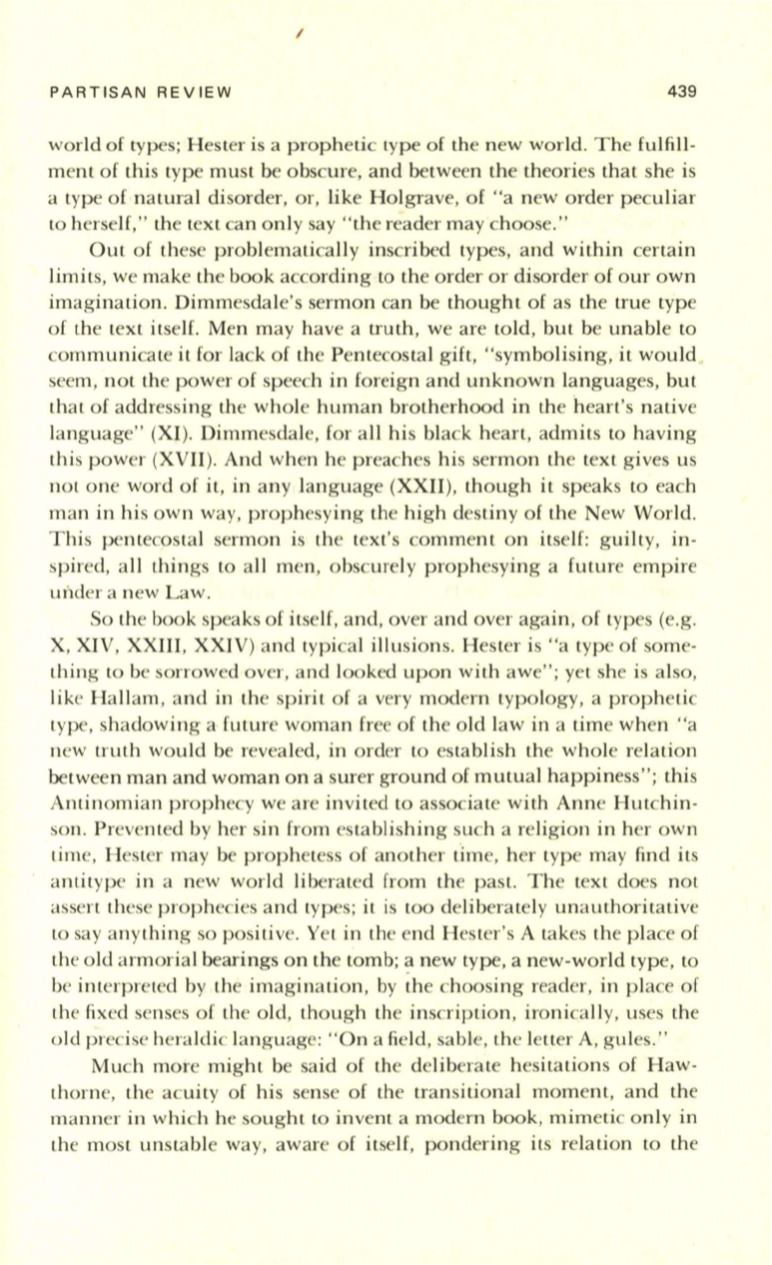
I
PARTISAN REVIEW
439
world of types; Hester is a prophetic type of the new world. The fulfill–
ment of this type must be obscure, and between the theories that she is
a type of natural disorder, or, like Holgrave, of "a new order peculiar
to
herself," the text can only say "the reader may choose."
Out of these problematically inscribed types, and within certain
limits, we make the book according to the order or disorder of our own
imagination. Dimmesdale's sermon can be thought of as the true type
of the text itself. Men may have a truth, we are told, but be unable to
communicate it for lack of the Pentecostal gift, "symbolising, it would
o
seem, not the power of speech in foreign and unknown languages, but
that of addressing the whole human brotherhood in the heart's native
language" (XI). Dimmesdale, for all his black heart, admits
to
having
this power (XVII). And when he preaches his sermon the text gives us
not one word of it, in any language (XXII), though it speaks
to
each
man in his own way, prophesying the high destiny of the New World.
This pentecostal sermon is the text's comment on itself: guilty, in–
spired, all things to all men, obscurely prophesying a future empire
under a new Law.
So the book speaks of itself, and, over and over again, of types (e.g.
X, XIV, XXIII, XXIV) and typical illusions. Hester is "a type of some–
thing to be sorrowed over, and looked upon with awe"; yet she is also,
like Hallam, and in the spirit of a very modern typology, a prophetic
type, shadowing a future woman free of the old law in a time when "a
new truth would be revealed, in order to establish the whole relation
between man and woman on a surer ground of mutual happiness"; this
Antinomian prophecy we are invited to associate with Anne Hutchin–
son . Prevented by her sin from establishing such a religion in her own
time, Hester may be prophetess of another time, her type may find its
antitype in a new world liberated from the past. The text does not
assert these prophecies and types; it is too deliberately unauthoritative
to
say anything so positive. Yet in the end Hester's A takes the place of
the old armorial bearings on the tomb;
~
new type, a new-world type, to
be interpreted by the imagination, by the choosing reader, in place of
the fixed senses of the old, though the inscription, ironically, uses the
old precise heraldic language: "On a field, sable, the letter A, gules."
Much more might be said of the deliberate hesitations of Haw–
thorne, the acuity of his sense of the transitional moment, and the
manner in which he sought to invent a modern book, mimetic only in
the most unstable way , aware of itself, pondering its relation
to
the


